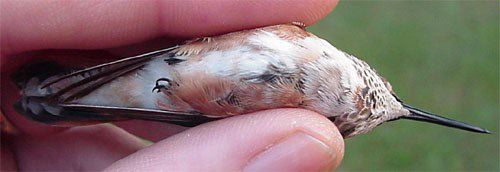 HOME: www.hiltonpond.org |
|||
|
RUFOUS HUMMINGBIRD |
 Our longtime friend Lyle Campbell, a geology prof at USC-Spartanburg, is deeply involved with the local Audubon chapter and alert for rare and unusual birds in his neck of the woods. Last week, he took a call from Nancy Gergen of Boiling Springs SC (Spartanburg County) and went with wife Sarah to observe an apparent Rufous Hummingbird at the Gergen residence. Knowing the importance of positively identifying this winter vagrant, the good Dr. Campbell contacted Hilton Pond Center, and we were quick to arrange a trip to the Gergens' for 20 November 2002.
Measurements of the Boiling Springs bird ruled out that it was an Allen's Hummingbird, Selasphorus sasin, and confirmed Rufous Hummingbird, S. rufus. The bird was already bringing in some of the rusty back feathers that are another sign of an adult male Rufous (above).
Vital Statistics for Rufous Hummingbird #Y14818
Age/Sex--Hatch-year male
In previous years, none of our banded vagrant hummers has kept its eyes shut for the entire banding process. Howeever, the Boiling Springs bird--like almost all the vagrants we have banded in 2002--was a "squinter" (top photo and below). Other banders we queried about this behavior said squinting happens occasionally happens when they band hummers in full sun, but most of our recent bandings have been on very overcast days and quite early in the morning in fairly dim light. Thus, we're at a loss to explain this "new" behavior epidemic.  We appreciate Lyle Campbell's alerting us to the Boiling Springs hummer, but especially thank Nancy Gergen for allowing us to band her Rufous at dawn. The bird seems pretty attached to Nancy--it was first spotted at her feeder about 1 October--and certainly wasn't in any hurry to fly from her hand after banding (below left).  ... ...
All text & photos © Hilton Pond Center
If you're interested in sharing your hummingbird observations and learning from other enthusiasts, you may wish to subscribe to Hummingbird Hobnob, our Yahoo!-based discussion group. Also be sure to visit our award-winning Web site for Operation RubyThroat: The Hummingbird Project; on it you'll find almost anything you want to know about hummingbirds, including more information about Hummingbird Banding.
For much more information about hummingbirds, visit Operation RubyThroat: The Hummingbird Project  |
 We got to Boiling Springs at 6:45 a.m., set up the portable hummer trap, and had the early bird in hand by 7:05 a.m. There was no doubt the hummer was a juvenile male Selasphorus; substantial rust in the tail was the first clue (right), and this bird also had more than ten large iridescent orange-red feathers on its throat--which by this time next year would show the complete metallic gorget of an adult male. (The top photo nicely illustrates that gorget color is caused not by pigments but by feather structure, which scatters and refracts light. The plumage on the side of the throat is brilliant because the early morning sun struck the feathers at just the right angle, while the center of the throat appears much less colorful--even though all the metallic throat feathers were exactly alike.)
We got to Boiling Springs at 6:45 a.m., set up the portable hummer trap, and had the early bird in hand by 7:05 a.m. There was no doubt the hummer was a juvenile male Selasphorus; substantial rust in the tail was the first clue (right), and this bird also had more than ten large iridescent orange-red feathers on its throat--which by this time next year would show the complete metallic gorget of an adult male. (The top photo nicely illustrates that gorget color is caused not by pigments but by feather structure, which scatters and refracts light. The plumage on the side of the throat is brilliant because the early morning sun struck the feathers at just the right angle, while the center of the throat appears much less colorful--even though all the metallic throat feathers were exactly alike.)


 Students at GLOBE-certified schools may submit winter hummingbird observations as part of Operation RubyThroat and GLOBE. Students can also correlate hummingbird observations with data on abiotic factors, including atmosphere, climate, hydrology, soils, land cover, and phenology. See the
Students at GLOBE-certified schools may submit winter hummingbird observations as part of Operation RubyThroat and GLOBE. Students can also correlate hummingbird observations with data on abiotic factors, including atmosphere, climate, hydrology, soils, land cover, and phenology. See the 


